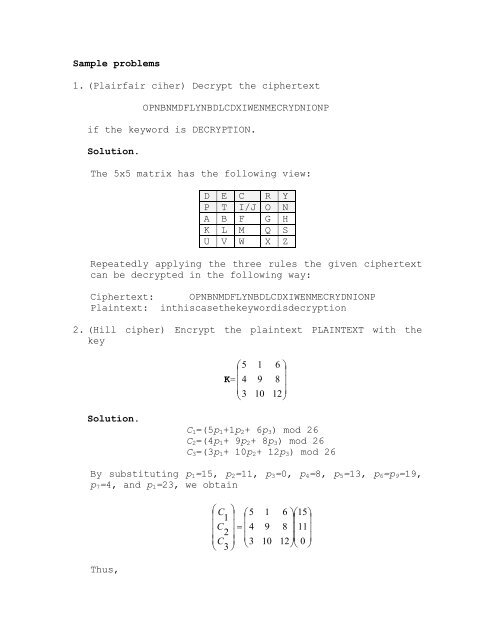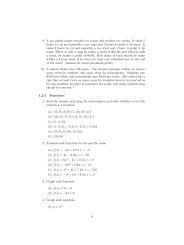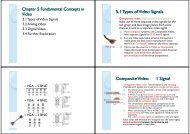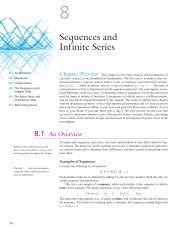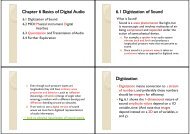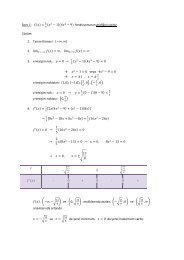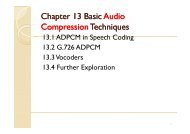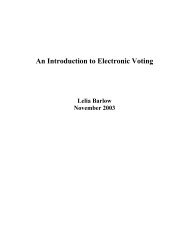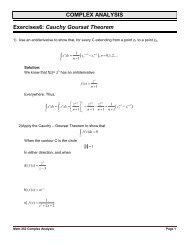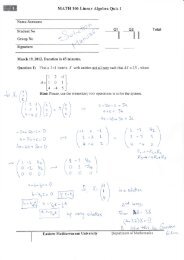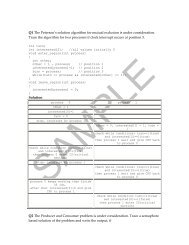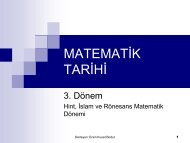Sample problems 1. (Plairfair ciher) Decrypt the ciphertext ...
Sample problems 1. (Plairfair ciher) Decrypt the ciphertext ...
Sample problems 1. (Plairfair ciher) Decrypt the ciphertext ...
Create successful ePaper yourself
Turn your PDF publications into a flip-book with our unique Google optimized e-Paper software.
<strong>Sample</strong> <strong>problems</strong><br />
<strong>1.</strong> (<strong>Plairfair</strong> <strong>ciher</strong>) <strong>Decrypt</strong> <strong>the</strong> <strong>ciphertext</strong><br />
OPNBNMDFLYNBDLCDXIWENMECRYDNIONP<br />
if <strong>the</strong> keyword is DECRYPTION.<br />
Solution.<br />
The 5x5 matrix has <strong>the</strong> following view:<br />
D E C R Y<br />
P T I/J O N<br />
A B F G H<br />
K L M Q S<br />
U V W X Z<br />
Repeatedly applying <strong>the</strong> three rules <strong>the</strong> given <strong>ciphertext</strong><br />
can be decrypted in <strong>the</strong> following way:<br />
Ciphertext: OPNBNMDFLYNBDLCDXIWENMECRYDNIONP<br />
Plaintext: inthiscase<strong>the</strong>keywordisdecryption<br />
2. (Hill cipher) Encrypt <strong>the</strong> plaintext PLAINTEXT with <strong>the</strong><br />
key<br />
Solution.<br />
⎛5<br />
⎜<br />
K= ⎜4<br />
⎜<br />
⎝3<br />
1<br />
9<br />
10<br />
6 ⎞<br />
⎟<br />
8 ⎟<br />
12⎟<br />
⎠<br />
C1=(5p1+1p2+ 6p3) mod 26<br />
C2=(4p1+ 9p2+ 8p3) mod 26<br />
C3=(3p1+ 10p2+ 12p3) mod 26<br />
By substituting p1=15, p2=11, p3=0, p4=8, p5=13, p6=p9=19,<br />
p7=4, and p1=23, we obtain<br />
Thus,<br />
⎛ ⎞<br />
⎜ C ⎟ ⎛5<br />
1 ⎜<br />
⎜C<br />
⎟ = ⎜4<br />
⎜ 2 ⎟<br />
⎜C<br />
⎟ ⎜<br />
⎝ ⎠ ⎝3<br />
3<br />
1<br />
9<br />
10<br />
6 ⎞⎛15⎞<br />
⎟⎜<br />
⎟<br />
8 ⎟⎜11⎟<br />
12⎟⎜<br />
⎟<br />
⎠⎝<br />
0 ⎠
C1= 5x15 + 1x11 + 6x0 = 75 + 11 + 0 = 86 mod 26 = 8 = I,<br />
C2= 4x15 + 9x11 + 8x0 = 60 + 99 + 0 = 159 mod 26 = 3 = D,<br />
C3= 3x15 + 10x11 + 12x0 = 45 + 110 + 0 = 155 mod 26 = 25<br />
= Z.<br />
Similarly,<br />
or<br />
⎛C<br />
4 ⎞ ⎛5<br />
⎜ ⎟ ⎜<br />
⎜C<br />
5 ⎟ = ⎜4<br />
⎜ ⎟ ⎜<br />
⎝C<br />
6 ⎠ ⎝3<br />
1<br />
9<br />
10<br />
6 ⎞⎛<br />
8 ⎞<br />
⎟⎜<br />
⎟<br />
8 ⎟⎜13⎟<br />
12⎟⎜<br />
⎟<br />
⎠⎝19⎠<br />
C4= 5x8 + 1x13 + 6x19 = 40 + 13 + 114 = 167 mod 26 = 5 =<br />
F,<br />
C5= 4x8 + 9x13 + 8x19 = 48 + 117 + 162 = 327 mod 26 = 15<br />
= P,<br />
C6= 3x8 + 10x13 + 12x19 = 24 + 130 + 228 = 382 mod 26 =<br />
18= S.<br />
Finally,<br />
or<br />
⎛C<br />
7 ⎞ ⎛5<br />
⎜ ⎟ ⎜<br />
⎜C<br />
8 ⎟ = ⎜4<br />
⎜ ⎟ ⎜<br />
⎝C<br />
9 ⎠ ⎝3<br />
1<br />
9<br />
10<br />
6 ⎞⎛<br />
4 ⎞<br />
⎟⎜<br />
⎟<br />
8 ⎟⎜23⎟<br />
12⎟⎜<br />
⎟<br />
⎠⎝19⎠<br />
C7= 5x4 + 1x23 + 6x19 = 20 + 23 + 114 = 157 mod 26 = 20 =<br />
U,<br />
C8= 4x4 + 9x23 + 8x19 = 16 + 207 + 162 = 385 mod 26 = 25<br />
= Z,<br />
C9= 3x4 + 10x23 + 12x19 = 12 + 230 + 228 = 470 mod 26<br />
=18= C.<br />
The plaintext encrypted results IDZFPSUZC.<br />
3. Suppose that we are using a Vigenere scheme with 27<br />
characters in which <strong>the</strong> twentyseventh character is <strong>the</strong><br />
space character, but with a one-time key that is as long<br />
as <strong>the</strong> given message. Given <strong>the</strong> <strong>ciphertext</strong>
YZRDTJVAROHOHOPS GXGG XQTJWSIQPJSPRZKOSNYOZX<br />
find <strong>the</strong> key that yields <strong>the</strong> following plaintext:<br />
Solution.<br />
MR MUSTARD WITH THE CANDLESTICK IN THE HALL<br />
a b c d e f g h i j K l m n o p q r s t u v w X y z<br />
A A B C D E F G H I J K L M N O P Q R S T U V W X Y Z<br />
B B C D E F G H I J K L M N O P Q R S T U V W X Y Z A<br />
C C D E F G H I J K L M N O P Q R S T U V W X Y Z A B<br />
D D E F G H I J K L M N O P Q R S T U V W X Y Z A B C<br />
E E F G H I J K L M N O P Q R S T U V W X Y Z A B C D<br />
F F G H I J K L M N O P Q R S T U V W X Y Z A B C D E<br />
G G H I J K L M N O P Q R S T U V W X Y Z A B C D E F<br />
H H I J K L M N O P Q R S T U V W X Y Z A B C D E F G<br />
I I J K L M N O P Q R S T U V W X Y Z A B C D E F G H<br />
J J K L M N O P Q R S T U V W X Y Z A B C D E F G H I<br />
K K L M N O P Q R S T U V W X Y Z A B C D E F G H I J<br />
L L M N O P Q R S T U V W X Y Z A B C D E F G H I J K<br />
M M N O P Q R S T U V W X Y Z A B C D E F G H I J K L<br />
N N O P Q R S T U V W X Y Z A B C D E F G H I J K L M<br />
O O P Q R S T U V W X Y Z A B C D E F G H I J K L M N<br />
P P Q R S T U V W X Y Z A B C D E F G H I J K L M N O<br />
Q Q R S T U V W X Y Z A B C D E F G H I J K L M N O P<br />
R R S T U V W X Y Z A B C D E F G H I J K L M N O P Q<br />
S S T U V W X Y Z A B C D E F G H I J K L M N O P Q R<br />
T T U V W X Y Z A B C D E F G H I J K L M N O P Q R S<br />
U U V W X Y Z A B C D E F G H I J K L M N O P Q R S T<br />
V V W X Y Z A B C D E F G H I J K L M N O P Q R S T U<br />
W W X Y Z A B C D E F G H I J K L M N O P Q R S T U V<br />
X X Y Z A B C D E F G H I J K L M N O P Q R S T U V W<br />
Y Y Z A B C D E F G H I J K L M N O P Q R S T U V W X<br />
Z Z A B C D E F G H I J K L M N O P Q R S T U V W X Y<br />
A B C D E F G H I J K L M N O P Q R S T U V W X Y Z<br />
As we know <strong>the</strong> key letter and plaintext letter identify<br />
<strong>the</strong> row, and <strong>the</strong> column, respectively. Hence, if <strong>the</strong><br />
<strong>ciphertext</strong> and plaintext letters are given, <strong>the</strong> key<br />
letter can found easily. As it follows from <strong>the</strong> above<br />
table <strong>the</strong> key used to encrypt <strong>the</strong> plaintext<br />
is<br />
MR MUSTARD WITH THE CANDLESTICK IN THE HALL<br />
MISS SCARLET WITH THE KNIFE IN THE SHOWROOM<br />
4. (Rail fence technique) Use rail fence technique to<br />
decrypt <strong>the</strong> following message<br />
ESENEIERNAUIESTATRMDTRAENNVRIY<br />
Solution.<br />
In <strong>the</strong> rail fence technique, <strong>the</strong> plaintext is written<br />
down as a sequence of diagonals and <strong>the</strong>n read off as a
sequence of rows. Implementing this technique to <strong>the</strong><br />
given <strong>ciphertext</strong> will result<br />
E S E N E I E R N A U I E S T<br />
A T R M D T R A E N N V R I Y<br />
That is, <strong>the</strong> plaintext is EASTERNMEDITERRANEAN UNIVERSITY<br />
5. Given <strong>ciphertext</strong> IYRMVLNSTLAEDTRSCEEIGIYSANLSII and <strong>the</strong><br />
key 3 6 1 2 5 4, use transposition technique based on<br />
writing <strong>the</strong> message in a rectangle, row by row, and<br />
reading <strong>the</strong> message off, column by column, with permuting<br />
<strong>the</strong> order of columns to decrypt it.<br />
Solution.<br />
We first split <strong>the</strong> given <strong>ciphertext</strong> in six blocks, <strong>the</strong>n<br />
write <strong>the</strong> blocks column-wise according to <strong>the</strong> given key,<br />
<strong>the</strong>n read <strong>the</strong> message in. As a result we obtain <strong>the</strong><br />
following table.<br />
3 6 1 2 5 4<br />
A S I N G L<br />
E C Y L I N<br />
D E R S Y S<br />
T E M I S T<br />
R I V I A L<br />
Hence, <strong>the</strong> message is ASINGLECYLINDERSYSTEMISTRIVIAL.<br />
6. (S-DES) Using S-DES, decrypt <strong>the</strong> string 10100010 using<br />
<strong>the</strong> key 0111111101 by hand. Show intermediate results<br />
after each function (IP, Fk , SW, Fk, IP -1 ). Then decode<br />
<strong>the</strong> first 4 bits of <strong>the</strong> plaintext string and <strong>ciphertext</strong><br />
string to a letters and <strong>the</strong> second 4 bits to ano<strong>the</strong>r<br />
letters where we encode A through P in base 2 (i.e.<br />
A=0000, B=0001 ,…, P=1111).<br />
Solution.<br />
S-DES Key Generation<br />
10-bit key : 0111111101<br />
Action Input Output<br />
P10 0111111101 1111110011<br />
LS-1 11111 10011 11111 00111<br />
P8 1111100111 01011111 (K1)
LS-2 11111 00111 11111 11100<br />
P8 1111111100 11111100 (K2)<br />
S-DES Encryption<br />
8-bit plaintext : 10100010 (KC)<br />
IP 10100010 00110001<br />
E/P 0001 10000010<br />
Excusive-OR 10000010, K1 11011101<br />
S0 1101 11<br />
S1 1101 00<br />
P4 1100 1001<br />
Excusive-OR 1001, 0011 1010<br />
SW 10100001 00011010<br />
E/P 1010 01010101<br />
Excusive-OR 01010101, K2 10101001<br />
S0 1010 10<br />
S1 1001 10<br />
P4 1010 0011<br />
Excusive-OR 0001,0011 0010<br />
IP -1 00101010 00111000<br />
8-bit <strong>ciphertext</strong> : 00111000<br />
S-DES <strong>Decrypt</strong>ion<br />
8-bit <strong>ciphertext</strong> : 00111000 (DH)<br />
IP 00111000 00101010<br />
E/P 1010 01010101<br />
Excusive-OR 01010101, K2 10101001<br />
S0 1010 10<br />
S1 1001 10<br />
P4 1010 0011<br />
Excusive-OR 0010,0011 0001<br />
SW 00011010 10100001<br />
E/P 0001 10000010<br />
Excusive-OR 10000010, K1 11011101<br />
S0 1101 11<br />
S1 1101 00<br />
P4 1100 1001<br />
Excusive-OR 1010,1001 0011<br />
IP -1 00110001 10100010<br />
8-bit plaintext : 10100010


